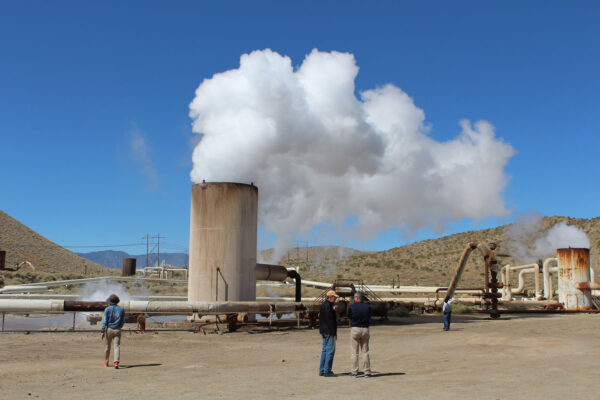Until recently, a niche energy source limited to hot springs The Coso geothermal field in Inyo County, California has been generating electricity from steam since 1987. Geothermal Rising via Flickr
We explore the issues, personalities, and trends that people are talking about around the West.
In the race of renewable energy technologies, geothermal energy has long been an also-ran. Its use in the country as a whole represents a tiny fraction of renewable energy (1.6 percent) and a tinier fraction (0.4 percent) of all energy.
But in western states, particularly California, Nevada, and Hawaii, where magma along the Ring of Fire is relatively close to fractures in the earth’s surface, it’s easier for engineers to reach hot rocks and hot groundwater. For more than six decades, the energy they provide has spun turbines and generated electricity – in 2022, 5.8 percent of California’s energy supply and 9.4 percent of Nevada’s.
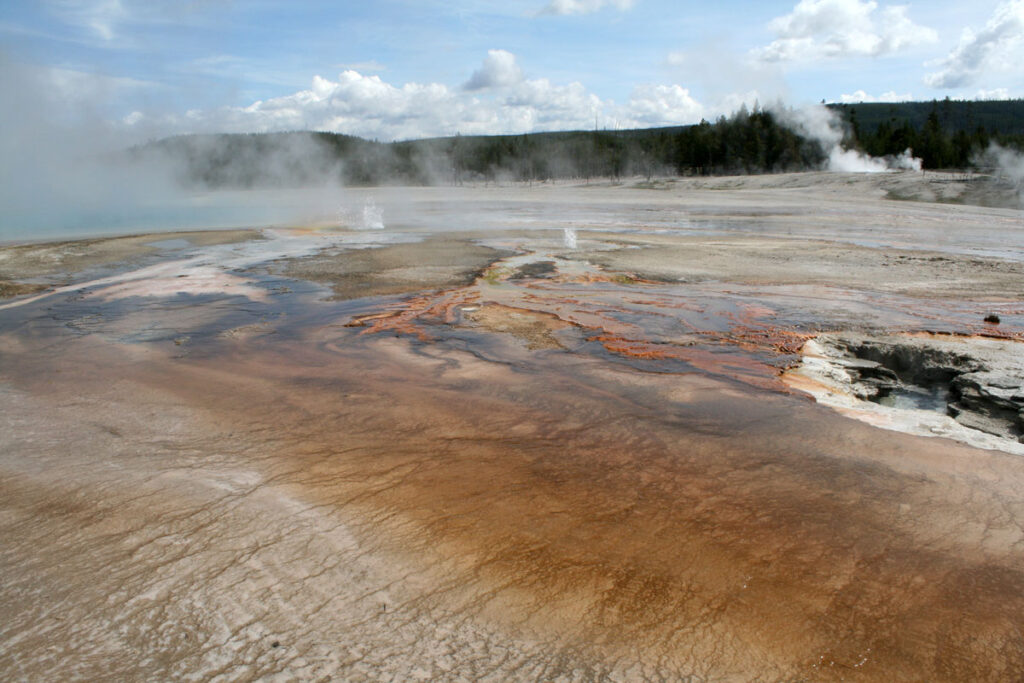
What’s happening now around the West could end geothermal energy’s subordinate status. As Jonah Wager, a clean energy expert in the White House Office of Science and Technology Policy, told a forum at South by Southwest in Austin in March, “Geothermal is not a new technology…What’s different about some of the technologies we’re seeing … is the way they expand the available resource.” More companies can produce geothermal power in more different ways.
“What excites me is that we are where wind and solar were ten or 15 years ago”
Cindy Taff, Sage Geosystems
The energy will be needed: the proliferation of data centers powering the internet, artificial intelligence, and cryptocurrency speculation all are accelerating electricity demand. As those uses threaten to soak up new renewable energy output, geothermal energy may become an important player. The federal Department of Energy [DoE] estimates that by 2050, new technologies could increase geothermal’s U.S. output from about 4 gigawatts to 90 gigawatts of electricity, enough to power 65 million homes.
“What excites me is that we are where wind and solar were ten or 15 years ago,” before those renewable sources took off, said Cindy Taff, CEO of the startup Sage Geosystems. Taff spent three decades in the oil and gas industry before leading one of the three geothermal startups created in the past seven years that have attracted the most attention and investment. Two others are Houston-based Fervo Energy and Calgary-based Eavor Technologies.
It’s no accident all three were born in hubs of the oil and gas industry, which for generations has brought buried resources to the surface to create electricity. “We’ve punched over a million holes in the ground in Texas since Spindletop,” the former oil and gas regulator Barry Smitherman told The Texas Tribune, referring to the 1901 oil strike that ushered in the state’s petrochemical era. “So we have a lot of knowledge, and we have a lot of history and skill set.” Smitherman chairs the Texas Geothermal Energy Alliance, a two-year-old industry advocacy group.
Sleepy geothermal technology is jolted awake by hydraulic fracking
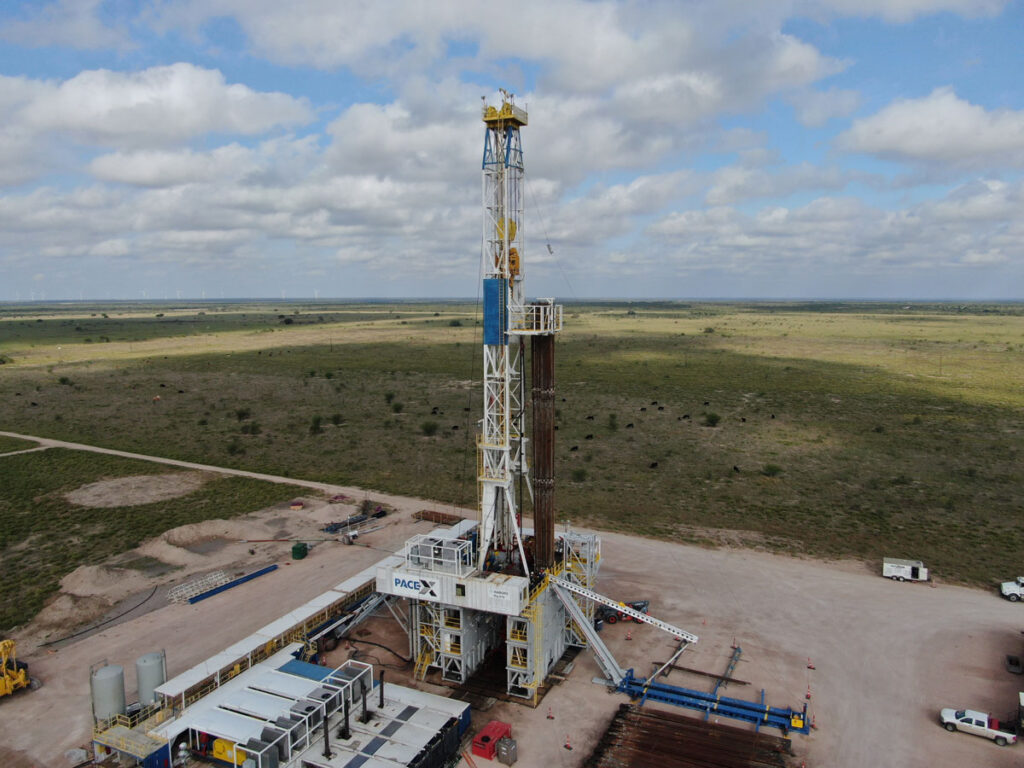
The transformation of geothermal projects began when operators realized that hydraulic fracking, which revolutionized the recovery of oil and gas reserves, could provide a way to capture heat through newly-created paths. Operators can use these to send fluids from the surface to meet the heat and bring its energy back to the surface.
The geothermal industry also adopted the oil and gas world’s improved drill bits, which are more effective at cutting hard rock. The polycrystalline diamond compact drill bit, said a recent DoE note, reduces costs by speeding geothermal well drilling, especially in the hard rock where much heat resides.
Many geothermal wells are deep, descending vertically through miles of volcanic and other types of rock. Fracking them at high pressure opens additional, mainly perpendicular pathways; the new angles allowing the liquid sent down the well to absorb more heat to be turned into reliable, affordable electricity.
Taff said of the three startups: “We are all targeting hot, dry rock in nontraditional ways.”
As Utility Dive reported, “By using geothermal power plants in a flexible manner and leveraging their energy storage abilities, the value of the resource could be dramatically increased and used to smooth out intermittent renewable energy….”
If geothermal can be used not just to generate energy but to store it, it can provide baseline power to bridge gaps in renewables.
Wind and solar power now account for 13 percent of America’s renewable power. But solar power doesn’t work when the sun doesn’t shine, and wind power fails when the wind doesn’t blow. If the geothermal industry can be used not just to generate energy but to store it, this additional capability means it can provide baseline power that can be switched on and off to bridge these gaps. This could replace the current sources of baseline power, usually fossil-powered plants. A recent Princeton study endorsed the new companies’ approaches.
Geothermal electricity generation is concentrated in America’s West. “While the United States accounts for 25 percent of the world’s installed geothermal energy capacity, western states contain fully 95 percent of that capacity,” Colorado Gov. Jared Polis wrote in as he launched the WGA’s geothermal energy program two years ago.

There remains enormous geothermal potential waiting to be tapped, and not just in the West. Roland N. Horne, an Earth Sciences professor at Stanford University, told an energy seminar in April, “if we want to recover commercial amounts of electricity, we have to sweep the heat from huge volumes of rock. I’m talking about cubic kilometers of rock. We have to have permeable access over” broad swaths of that rock, he said. Fracking could accomplish that.
Separately, Horne told a Wall Street Journal podcast, “If we drill sufficiently deep, actually we could have geothermal anywhere and everywhere.”
Down deep, “hot dry rock” represents a difficult but abundant source of geothermal energy
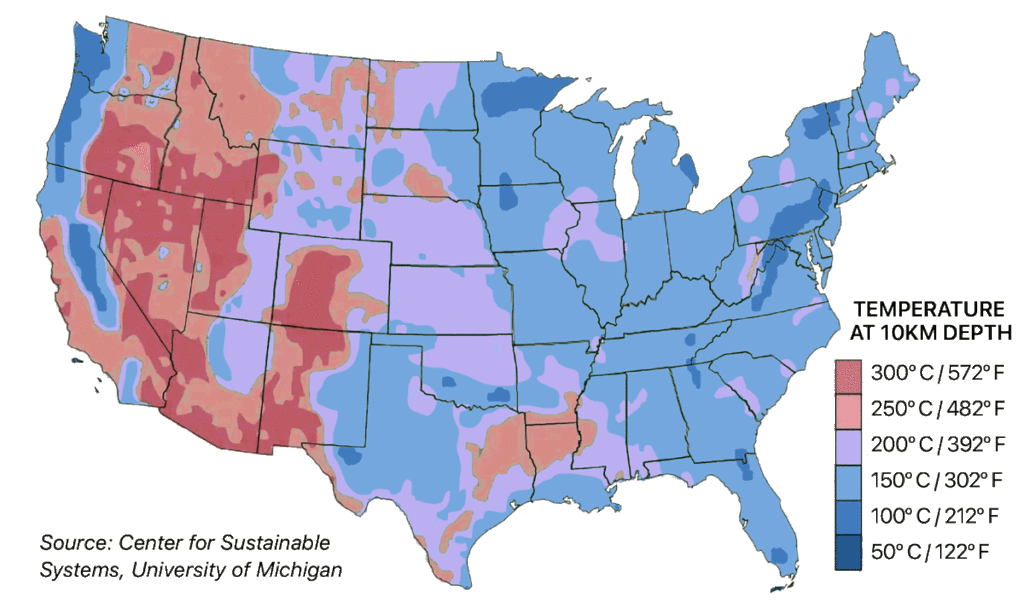
Apart from hot springs close to the surface, the heat undergirding western states has never been easily accessible. But recent successful trials in Utah show that is changing. In 2019, the Frontier Observatory for Research in Geothermal Energy, or FORGE, a DoE program, set up shop in Utah’s Beaver County. The University of Utah manages the effort.
Apart from hot springs close to the surface, the heat undergirding western states has never been easily accessible.
Following a Department of Energy plan, FORGE is experimenting with everything from horizontal drilling to tracking the flow of fluids through the newly-fracked rock to how the fluids impact the fractures. Last year the Pacific Northwest National Laboratory opened the Center for Understanding Subsurface Signals and Permeability to increase understanding of subsurface activity and to learn to control the flow of fluids through the fractures.
As Utah Business reported, “In Beaver, FORGE created a set of tests to explore the area’s geothermal viability, laying the groundwork for companies to easily move into the county and develop their projects.”
This is how The New York Times described FORGE’s method: “First, drill two wells shaped like giant L’s, extending thousands of feet down into hot granite before curving and extending thousands of feet horizontally. Then, use fracking, which involves controlled explosives and high-pressure fluids, to create a series of cracks between the two wells.” Injected water migrates through the cracks to the hot rocks. Heated up to 300 degrees Fahrenheit, it comes out the second well and thence to the surface.
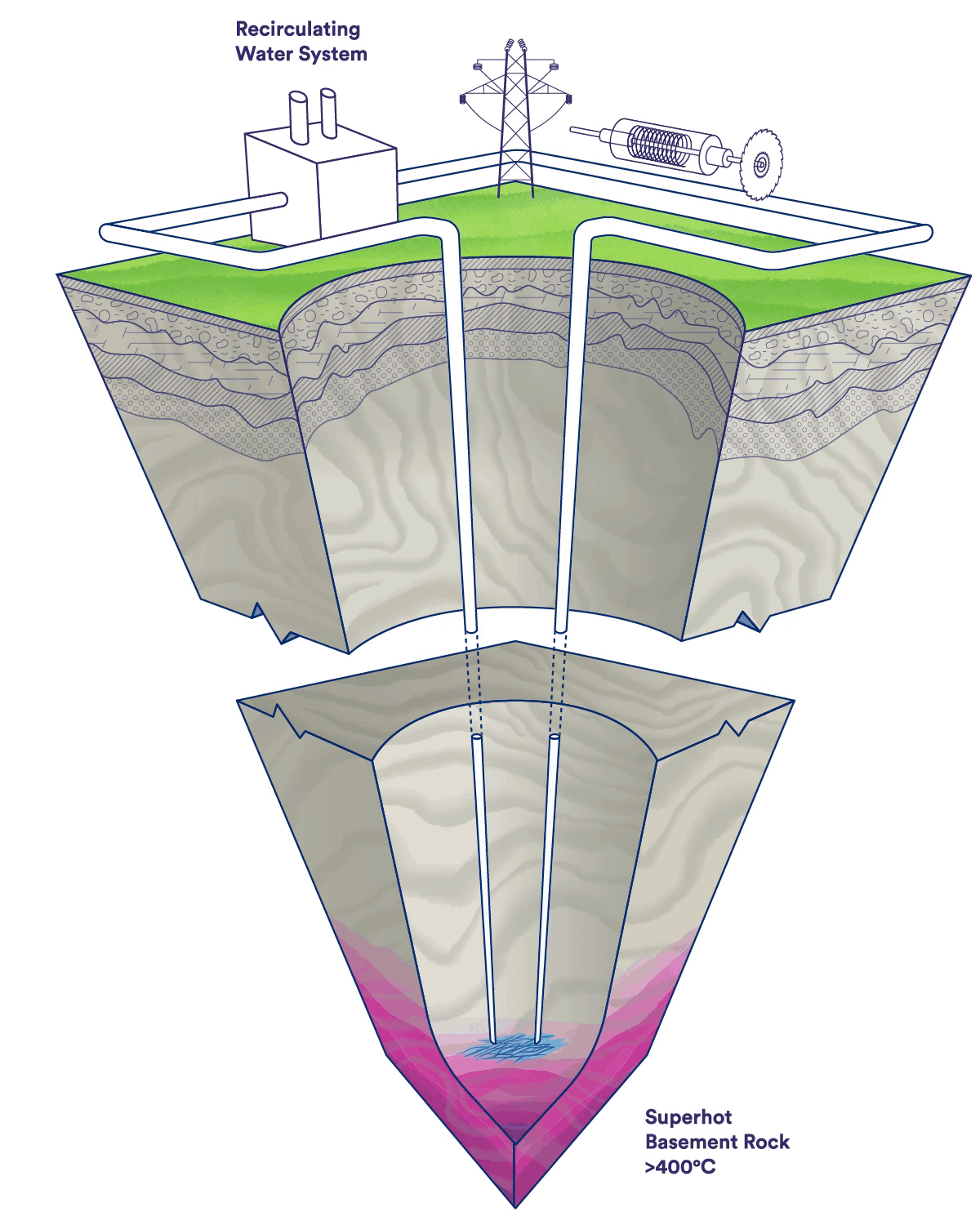
“Texas-based geothermal developer Fervo Energy noticed FORGE’s work,” Utah Business reported. It experimented with a related technology and last year declared that its trial in the northern Nevada hamlet of Blue Mountain proved the technology’s commercial viability.
Enhanced Geothermal Systems, or EGS, is the current name for the technology. Originally called “hot dry rock,” the Los Alamos National Laboratory developed it and first tried it out 47 years ago. “It worked, kind of, but not very well,” Horne said. In recent years, operators began to repurpose the technology, using horizontal drilling and fracking in combination to create pathways for injected fluids to capture the heat.
A Sierra Magazine report from last year’s Geothermal Rising Conference in Reno said, “With EGS, the Department of Energy estimates that geothermal’s contribution to U.S. energy will balloon to more than 10 percent by 2050.” It added, “many attendees told me that’s grossly underselling the potential.”
“Solving repeatability”: to drive adoption, geothermal technology must reduce the risk of failed wells

In the past, the word potential was seldom used for geothermal technology. The West’s most established geothermal energy projects in California include Calpine’s 65-year-old operations at The Geyers in Sonoma County, the world’s largest geothermal field with a capacity of 900 megawatts, and 11 geothermal plants far to the south in California’s Imperial County, whose combined capacity is about 345 megawatts.
There is a large cluster of plants in western Nevada; the federal Bureau of Land Management reported that plants in its region have a combined capacity of more than 400 megawatts.
Jack Norbeck, who had been a PhD student in Horne’s Geothermal Program, joined Tim Latimer, a Stanford business school graduate, to form Fervo in 2017. Latimer, the chief executive, told a 2023 Breakthrough Energy conference that the difficulty of exploiting hot spots with precise geological and hydrological characteristics meant “we went through a period… when there was little interest in geothermal.”
He added, “If geothermal wants to keep advancing to move beyond a niche energy source, the key thing you need is to solve repeatability” – guaranteeing that many hot spots can be exploited.
A range of approaches, from artificial hot springs to underground radiators and pressure-driven engines

As Wired magazine explained Fervo’s technology, “Instead of drilling into a natural hydrothermal system, Fervo dug into rock that is completely dry and effectively created an artificial hot spring by pumping down water that returns to the surface much hotter.” Creating fractures and connecting horizontal wells in hot rock allows fluid to flow across large areas of superheated surfaces and get superheated itself. A second vertical well carries heated fluid upwards to spin turbines and create electricity.
“Fervo dug into rock that is completely dry and effectively created an artificial hot spring by pumping down water that returns to the surface much hotter.”
Latimer, who started his career as an oil and gas engineer, told the Breakthrough Energy audience that the key in Fervo’s system is changing the configuration of the hot rocks. “A lot of our innovation is not inventing these tools from scratch but taking what’s already been done in the oil and gas industry and making the drill bits, motors and data collection tools work in bigger wells, higher temperature wells, harder geologies.”
Fervo completed its 3.5 megawatt demonstration project in Blue Mountain, Nevada last year. According to a Department of Energy report, it is “the first commercial pilot of enhanced geothermal systems leveraging these new capabilities.” Google now uses the facility to power its Nevada data centers.
Eavor’s approach is different; it has developed a massive underground radiator. As Sierra Magazine described it: “In 2022, the Calgary-based energy company demonstrated a novel approach to generating geothermal power in a remote patch of the New Mexico desert. Its “Eavor-Loop” method doesn’t rely on fracking or hot water from underground aquifers but instead creates a closed-loop system for circulating fluid and generating heat through conduction. That means it can be deployed almost anywhere on Earth with minimal environmental risk.”
After two expensive demonstration projects – drilling a well 3.5 miles deep in southwestern New Mexico, and constructing a demonstration project in Alberta, Canada, Eavor is building its first commercial project in the German town of Geretsried. It plans to be operational in 2026, producing more than 8 megawatts of electricity.
Sage Geosystems’ energy production technology doesn’t involve creating a loop, but using two deep wells interconnected at the surface that operate like a multiple-cylinder engine. One well sends hot water upward to turn a binary cycle turbine while the other receives cooler water to heat. When the first well has completed its production cycle, the second is hot. The two reverse roles every 12 hours to provide baseload power generation.
Sage has an even more distinct approach to storing energy. As Taff explained to the Path To Zero podcast, “We drill a well. We install a frack in a very impermeable formation. … We pump water into the fracture. The fracture will balloon open. You shut the wellhead valve and then that water is trapped in that fracture under pressure.”
She continued, “When that demand peaks, you open that wellhead valve. The fracture is wanting to close. When it does, it jettisons the water” upward, to spin turbines and generate electricity. In effect, the balloon-like reservoir under pressure is a battery, providing energy on demand. Sage’s first commercial operation, a three-megawatt facility, will be built in an area south of San Antonio, Texas, Taff said; investors have put in $17 million.
“If you can drive the cost down, there’s going to be exponential growth.”
In an interview, Taff said it’s essential to reduce geothermal energy’s price. “The technology is sexy and fun,” she said, “but unless you can drive the cost down it’s not going to be fun for long. If you can drive the cost down, there’s going to be exponential growth.”
“Cost and capital are issues for geothermal production,” Horne said. “And you can’t have any income from a geothermal project until everything is built.”
Investments are flowing toward a “funky” but promising technology

Sierra Magazine reported that “The needed capital investment for geothermal ranges from $3,000 to $6,000 per kilowatt-hour. Solar and terrestrial wind run just $1,700 to $2,100 per kilowatt-hour. EGS is nascent technology; its price will fall, but not if the industry hangs like a fly in a web of red tape, regulatory hurdles, and permitting hassles. On average, it takes seven to 10 years for a geothermal project to come to fruition…”
Jamie C. Beard, the founder of Project InnerSpace, a geothermal-adjacent company, told this year’s South by Southwest conference, “Geothermal’s kind of funky. It doesn’t fit well into venture capital models. It’s got too much risk.”
Investment is happening nonetheless. Some comes from governments: the DoE recently announced it is investing $60 million in three companies, including Fervo. Eavor received $90 million Canadian dollars from Canada’s government. States and provinces are chipping in: The New Mexico legislature and its governor this year agreed to create both a $2.5 million geothermal development fund and a $2.5 million revolving loan fund to help support projects. Colorado’s legislature just awarded a total of $7.7 million to support 35 local geothermal projects. Alberta awarded Eavor $2 million in Canadian dollars to support development of its German facility.
The private sector is the most important player. Before Sage got its recent infusion of $17 million, Fervo announced it completed a $244 million fundraising round. It had raised $138 million last year. Eavor last year raised $182 million.
Returns on investment will come when the energy is available and competitively priced. A 2023 study from the Lawrence Berkeley National Laboratory found the retail cost of geothermal electricity significantly exceeded that of solar and wind-powered electricity. It suggested that “policy intervention and continued R&D investments may be warranted to sustain a vibrant geothermal industry that stands ready to contribute to the late stages of decarbonization.”
The website ThinkGeoEnergy.com found the price gap narrowed when the cost of other renewables was combined with storage costs. But geothermal was still more expensive than utility-scale wind or solar power. “With different technology, as an industry, we are going to crack that nut,” Taff predicted.
If final hurdles are overcome, envisioning a “geothermal renaissance”
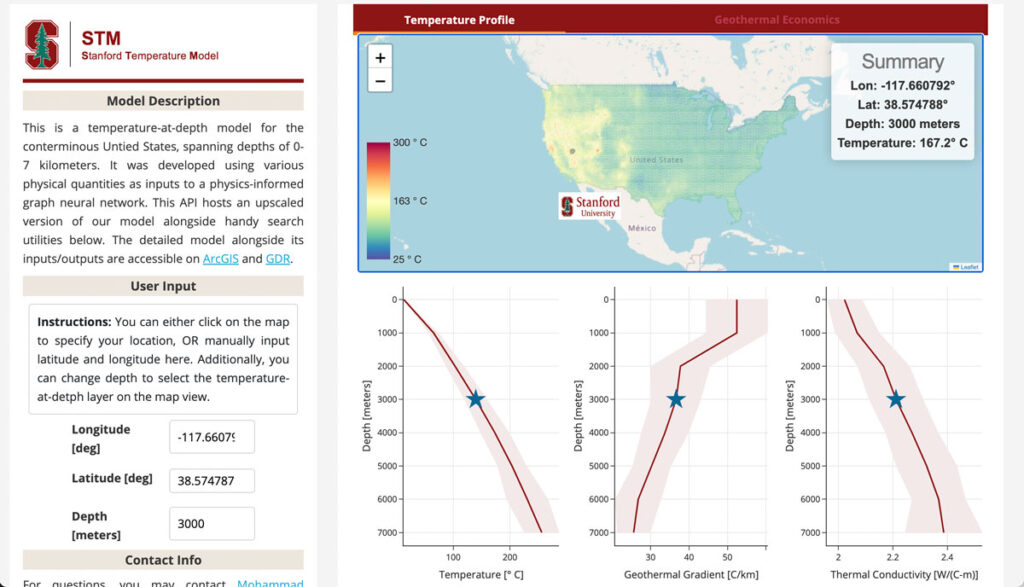
Attracting investment is one hurdle. Getting power to customers – either in localized areas, like the small Arizona mining operation Sage plans to power, or across regional grids – is another. New hook-ups and transmission lines will be needed.
In addition, as Beard of Project InnerSpace said, few maps show detailed views of geothermal resources – especially at different depths beneath the surface. That too is changing. Stanford University’s Geothermal Program recently released the Stanford Temperature Model, a map of the continental United States showing varying levels of heat up to seven kilometers below the surface. In addition, Project Innerspace is working with Google to make new worldwide maps: Google Earth for geothermal. The beta version, covering Africa, was released last year.
Other issues include earthquakes – as oil and gas companies know, fracking can produce small local tremors; a study by the University of California, Riverside, confirmed this. Earthquakes can quickly turn people against the technology. Horne, the Stanford professor, said in his recent seminar, “That is a risk of social license if you produce earthquakes that affect people’s lives.”
Understanding how to prevent small earthquakes from fracking, increasing the speed of drilling to lower the upfront costs, and finding more variants of drilling and fracking systems means “a geothermal renaissance,” proclaimed Horne’s final lecture slide.
Edited by Geoff McGhee.

